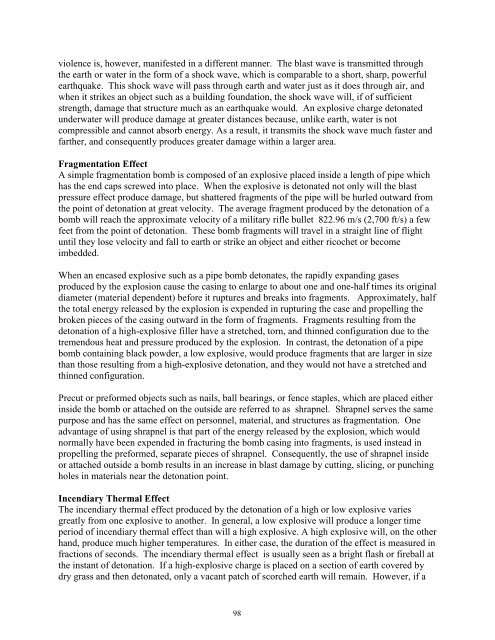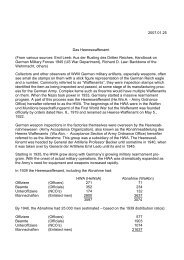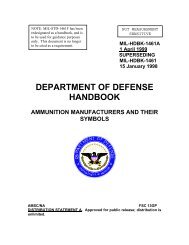Explosives-Nature, Use, Effects and Application.pdf
Explosives-Nature, Use, Effects and Application.pdf
Explosives-Nature, Use, Effects and Application.pdf
You also want an ePaper? Increase the reach of your titles
YUMPU automatically turns print PDFs into web optimized ePapers that Google loves.
violence is, however, manifested in a different manner. The blast wave is transmitted through<br />
the earth or water in the form of a shock wave, which is comparable to a short, sharp, powerful<br />
earthquake. This shock wave will pass through earth <strong>and</strong> water just as it does through air, <strong>and</strong><br />
when it strikes an object such as a building foundation, the shock wave will, if of sufficient<br />
strength, damage that structure much as an earthquake would. An explosive charge detonated<br />
underwater will produce damage at greater distances because, unlike earth, water is not<br />
compressible <strong>and</strong> cannot absorb energy. As a result, it transmits the shock wave much faster <strong>and</strong><br />
farther, <strong>and</strong> consequently produces greater damage within a larger area.<br />
Fragmentation Effect<br />
A simple fragmentation bomb is composed of an explosive placed inside a length of pipe which<br />
has the end caps screwed into place. When the explosive is detonated not only will the blast<br />
pressure effect produce damage, but shattered fragments of the pipe will be hurled outward from<br />
the point of detonation at great velocity. The average fragment produced by the detonation of a<br />
bomb will reach the approximate velocity of a military rifle bullet 822.96 m/s (2,700 ft/s) a few<br />
feet from the point of detonation. These bomb fragments will travel in a straight line of flight<br />
until they lose velocity <strong>and</strong> fall to earth or strike an object <strong>and</strong> either ricochet or become<br />
imbedded.<br />
When an encased explosive such as a pipe bomb detonates, the rapidly exp<strong>and</strong>ing gases<br />
produced by the explosion cause the casing to enlarge to about one <strong>and</strong> one-half times its original<br />
diameter (material dependent) before it ruptures <strong>and</strong> breaks into fragments. Approximately, half<br />
the total energy released by the explosion is expended in rupturing the case <strong>and</strong> propelling the<br />
broken pieces of the casing outward in the form of fragments. Fragments resulting from the<br />
detonation of a high-explosive filler have a stretched, torn, <strong>and</strong> thinned configuration due to the<br />
tremendous heat <strong>and</strong> pressure produced by the explosion. In contrast, the detonation of a pipe<br />
bomb containing black powder, a low explosive, would produce fragments that are larger in size<br />
than those resulting from a high-explosive detonation, <strong>and</strong> they would not have a stretched <strong>and</strong><br />
thinned configuration.<br />
Precut or preformed objects such as nails, ball bearings, or fence staples, which are placed either<br />
inside the bomb or attached on the outside are referred to as shrapnel. Shrapnel serves the same<br />
purpose <strong>and</strong> has the same effect on personnel, material, <strong>and</strong> structures as fragmentation. One<br />
advantage of using shrapnel is that part of the energy released by the explosion, which would<br />
normally have been expended in fracturing the bomb casing into fragments, is used instead in<br />
propelling the preformed, separate pieces of shrapnel. Consequently, the use of shrapnel inside<br />
or attached outside a bomb results in an increase in blast damage by cutting, slicing, or punching<br />
holes in materials near the detonation point.<br />
Incendiary Thermal Effect<br />
The incendiary thermal effect produced by the detonation of a high or low explosive varies<br />
greatly from one explosive to another. In general, a low explosive will produce a longer time<br />
period of incendiary thermal effect than will a high explosive. A high explosive will, on the other<br />
h<strong>and</strong>, produce much higher temperatures. In either case, the duration of the effect is measured in<br />
fractions of seconds. The incendiary thermal effect is usually seen as a bright flash or fireball at<br />
the instant of detonation. If a high-explosive charge is placed on a section of earth covered by<br />
dry grass <strong>and</strong> then detonated, only a vacant patch of scorched earth will remain. However, if a<br />
98




